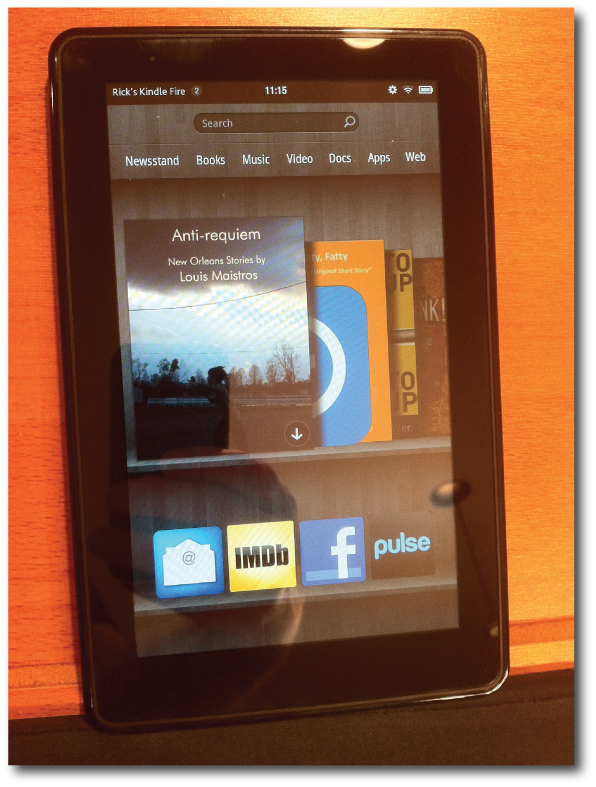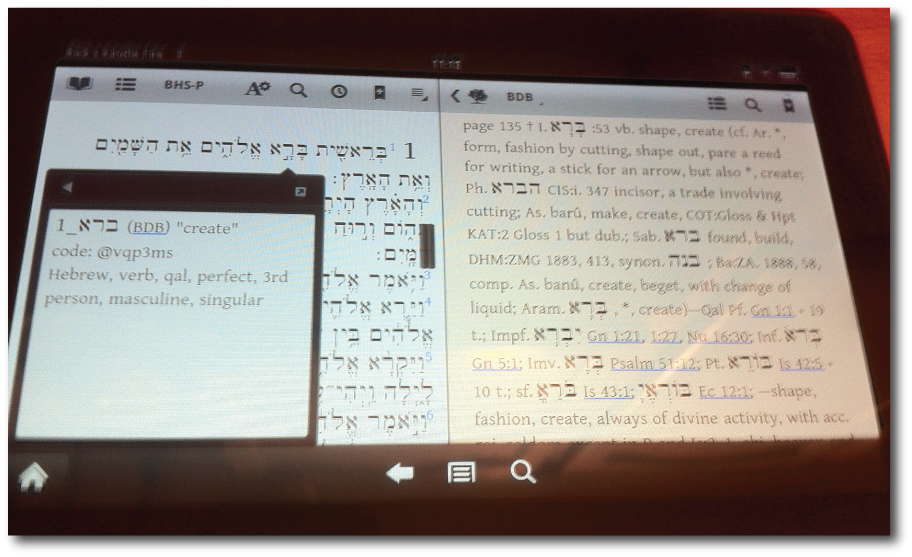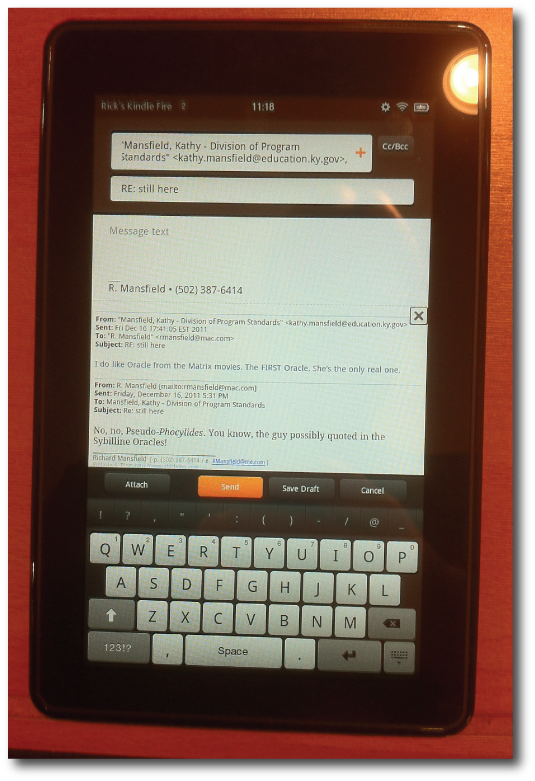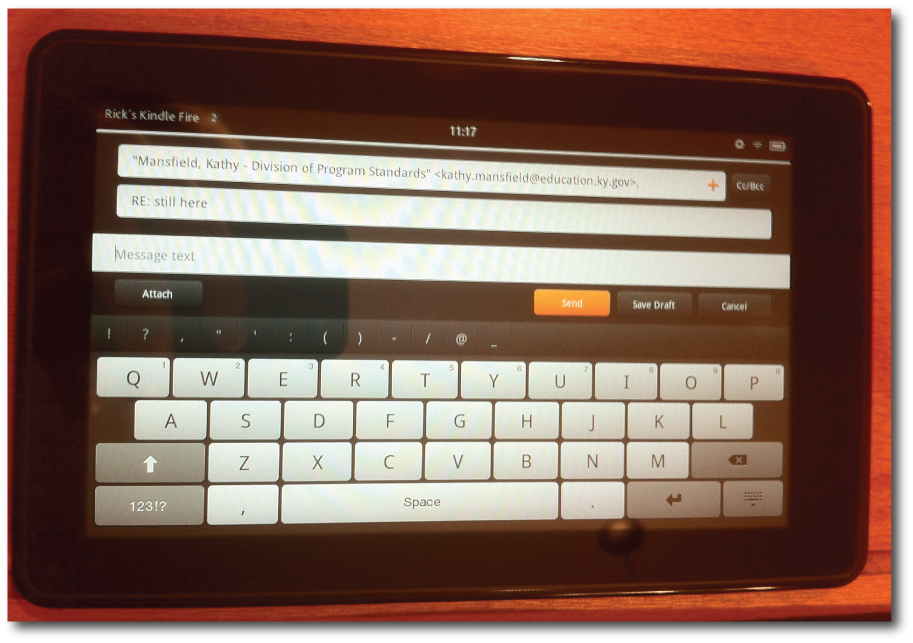I've had a Kindle Fire "loaner" for the past three weeks or so, and before I have to give it up tomorrow, I thought I'd write down some thoughts. I'll start with the more positive aspects and gradually merge my way into some caveats and concerns.

- For what it is—a $199 customized Android tablet—the Kindle Fire is fantastic. Although Amazon has set a new price point with devices of this size, all reports indicate that they're losing money on each Fire, while presumably making it up on content. As long as expectations aren't greater than reality, the value of the tablet is a good deal.
- I have not had the wifi problems with my Fire that some people have reported.
- Some have reported the Kindle Fire is too heavy. I remember hearing similar things about the iPad when it was first released. To all these folks, I want to suggest a gym membership to go with their New Year's resolutions to get in shape. I will say that the Kindle Fire feels very solid, unlike some of the cheap-feeling tablets near this price point and even higher ones.
- Streaming video services like those of Amazon's own Prime or Netflix (which is an app that can be added to the fire), significantly add to the value of the device.
- The Kindle Fire might be the perfect device for a child not quite old enough to have a cell phone. I think in the right context, kids could make a lot of use out of the Fire for all it's major intentions: reading, music, video and games. Kids who are casual gamers will genuinely appreciate the screen, which is larger than that of an iPod Touch or Nintendo handheld.
- One caveat for parents who want to give a Kindle Fire to a child: parental controls are very limited as compared to an iPad. There's very little to stop a child from purchasing books, apps, movies and music and a parent's credit card could get maxed out pretty quickly. Of course, I'm certain that Amazon will improve parental controls over time, but until then a Kindle Fire for a child ought to come with a discussion about responsibility.
- I have not used the Fire with a cover, although I'd probably recommend one for sake of protection. However, without a cover, it's still small enough to fit inside an inside jacket pocket, but the addition of a cover might make the pocket a bit snug.
- There was an initial moment of delight, when after entering my Amazon credentials, the device immediately populated with books, music and other media I've bought from Amazon over the years. If you're already in the Amazon "ecosystem" of digital content, the Kindle Fire will be highly personalized for you from the moment you begin using it.
- With only 8 GB of storage, the Fire truly is designed to be a cloud based device. There's no "Archive" for my books. Rather, all books are on the "carousel" on the homescreen. If I want to read one, it is downloaded by touching it. Make certain that if you are planning to travel with the Kindle Fire and want to watch movies on it, you have verified the videos are truly downloaded and can be viewed without a connection to the internet.
- Although my feelings are generally positive about the Kindle Fire, there's no practical reason for someone such as myself, who already owns an iPad and uses it heavily to get a Fire. I've got an iPhone (smaller screen) and an iPad (larger screen), and I simply can't figure out what I'd do with an in-between screen on a regular basis. And as regular readers of This Lamp already know, when it comes to reading ebooks, I prefer the E Ink Kindle, even over the iPad.
- There's already a lot of quality apps available for the Fire in Amazon's curated app store. Note also there is a setting in the Fire's preferences that allows other Android apps to be installed. So, yes, that means that the Kindle Fire can not only read Amazon Kindle book titles, but if the Nook app is obtained by means outside Amazon's app store, titles obtained from Barnes and Noble can be read, too.
 Above: Olive Tree's BibleReader app displaying a tagged Hebrew Bible on the left and the Brown-Drivers-Briggs lexicon on the right.
Above: Olive Tree's BibleReader app displaying a tagged Hebrew Bible on the left and the Brown-Drivers-Briggs lexicon on the right.
- The Kindle Fire is even more zen-like in its simplicity than the Kindle Touch. Whereas the Touch has only two buttons, the Fire just has one—a power button. The Home button, ubiquitous on all other Kindle devices, is found only on the screen in nearly all applications.
- As many have reported, because Amazon places the power button on the bottom, it really is easy to accidentally turn the Fire off while it's being used. Getting a cover for the Fire will probably solve this problem.
- Although Amazon supposedly isn't targeting the Kindle Fire toward potential iPad customers, it will undoubtedly encroach upon Apple's lowest-cost iPad. And despite the fact that Apple says 7" tablets aren't as functional, I feel certain that they will release a 7" iPad in addition to their regular lineup, sometime in 2012.
- If you're trying to decide between the Kindle Fire and the iPad, carefully consider what you intend to do with the device you choose. Early critics of the iPad panned it as merely a content-consumption device, not made for real work. Then people began creating content and doing real work on the iPad, significantly changing its perceived pupose. I could be wrong, but I don't expect this to happen to the Fire. I really feel it's going to primarily remain a device for media consumption—books, music, video, and games. If you think the Fire is going to be a laptop replacement or even an iPad replacement, you're probably going to be disappointed.
- Related to the above point, when the Fire was first announced, Seth Meyers, on SNL's weekend update, said of the Fire, "It's expected to sell well among parents who always buy the wrong thing." That may or may not be true. But think carefully before buying a Fire this Christmas for someone who actually wants an iPad.
- The Kindle Fire's screen isn't always as responsive as an iOS device, but this is true for just about every Android device I've ever used.
- Although the Fire can receive and send email, like a mobile phone, it's not practical for extensive correspondence. Turned vertically, the keyboard works only with thumb-typing; and turned horizontally, the keyboard is still smaller than the tiniest netbook keyboard and can be an exercise in frustration. What's worse, when turned horizontally, only one line of edited text can be seen at a time.
 Above: the Fire's email app in vertical orientation. Thumb-typing is going to work best here.
Above: the Fire's email app in vertical orientation. Thumb-typing is going to work best here.
 Above: email app in landscape orientation. The keyboard is bigger, but you're not going to be touch-typing. And you can see only one line of the text you're writing.
Above: email app in landscape orientation. The keyboard is bigger, but you're not going to be touch-typing. And you can see only one line of the text you're writing.
- I didn't spend a lot of time in the Fire's "Silk" browser. It's fine for what it is, and it's better than browsing the web on a mobile phone, but I would not want to spend long amounts of time using it. If a website offers a mobile version of its content, you'll definitely want to use it when viewing via the Fire.
- While I do believe the Kindle Fire is going to be successful, it probably won't be as successful as some might have initially thought. Millions of Fires were pre-ordered, no doubt simply based on Amazon's good reputation in regard to its previous line of Kindles. But now I'm reading reports of the Kindle Fire being returned for various reasons. Some have returned it for technical problems, while others may have simply realized it wasn't as useful as they initially thought. My concern is that for many people, after the newness of the Kindle Fire wears off, it might be shut up in a drawer and rarely used at all.
- There's no video-out on the Fire, which is too bad. It would have been a nifty device to connect to a projector for classroom use.
Would I recommend the Kindle Fire? Absolutely, but the buyer should think about what he or she wants to do with the device and make the decision based upon whether the Fire will handle those needs. Again, it's a great value for $199, but don't be fooled into thinking it's going to match the features of larger tablets, let alone notebook computers.